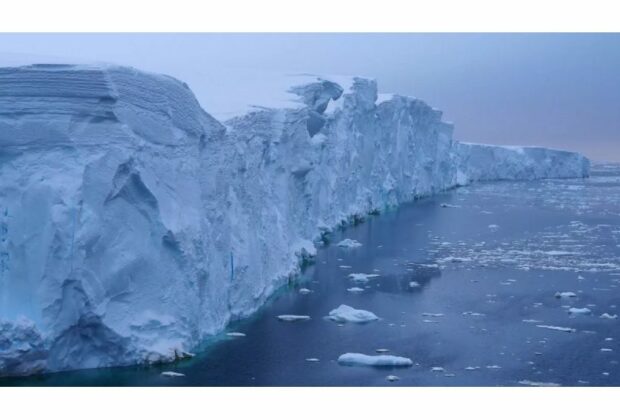The outlook for the “Doomsday Glacier” has grown more dire. Scientists warn that the Thwaites Glacier, part of the Antarctic Ice Sheet, will deteriorate “further and faster,” potentially causing significant sea level rise that could affect “hundreds of millions” in coastal communities.
“By the end of this century, or into the next, we are likely to see a rapid increase in ice loss from Antarctica,” said Dr. Ted Scambos, a glaciologist at the University of Colorado. “The Thwaites is essentially doomed.”
These findings are the result of six years of research by the International Thwaites Glacier Collaboration, involving over 100 scientists. The Thwaites Glacier, roughly the size of Florida, is among the world’s largest glaciers, and its collapse could raise sea levels by up to 65 centimeters (about 26 inches). However, if the surrounding glacial basins are taken into account, the total rise could reach closer to three meters.
Researchers noted that the volume of water flowing from the Thwaites and nearby glaciers into the ocean has doubled since the 1990s. Currently, about one-third of the glacier’s front is protected by a floating ice shelf, which limits the flow of ice into the sea. However, Scambos indicated that melting is accelerating and the ice sheet is nearing a critical point of breakup. “In the next two or three years, it will likely fracture into large icebergs,” he explained. This will expose the glacier’s front, altering how ocean waters interact with the ice shelf, though it may not immediately accelerate melting.
Key ridges in the bedrock that currently slow ice flow into the ocean are also eroding. As the Thwaites collapses, it will lose contact with these stabilizing features, leading to increased ice discharge into the ocean.
Surprisingly, researchers discovered that tidal activity is pumping warmer seawater into the glacier at high speed. This water, slightly above freezing, gets trapped beneath the glacier, melting freshwater ice and then being expelled, creating a continuous cycle.
The new insights from the International Thwaites Glacier Collaboration build on extensive research indicating how glaciers worldwide contribute to sea level rise. In May, a study revealed that high-pressure ocean water is seeping beneath the Thwaites, causing vigorous ice melt. Study co-author Christine Dow labeled the Thwaites the “most unstable place in the Antarctic,” noting that its rapid melting could have devastating impacts on global coastal communities.
Researchers from the University of California, Irvine, project that ocean levels could rise by about 60 centimeters (23.6 inches), aligning with the predictions from the International Thwaites Glacier Collaboration. Meanwhile, experts have raised alarms about the Greenland ice sheet, which is currently the leading driver of sea level rise. If it were to melt entirely, it could result in a rise of 20 to 25 feet.
Rising global temperatures linked to climate change have warmed oceans and altered wind patterns, making glaciers more vulnerable to melting. “This is very likely connected to increasing greenhouse gases in the atmosphere, which have shifted wind patterns and ocean circulation around Antarctica,” Scambos explained. “That’s the main culprit.”
Without intervention, scientists predict that the Thwaites could completely vanish by the 23rd century.








